Paper Menu >>
Journal Menu >>
 American Journal of Plant Sciences, 2012, 3, 1594-1607 http://dx.doi.org/10.4236/ajps.2012.311193 Published Online November 2012 (http://www.SciRP.org/journal/ajps) Weed Control, Environmental Impact and Profitability of Weed Management Strategies in Glyphosate-Resistant Corn Nader Soltani1*, Christie L. Stewart2, Robert E. Nurse3, Laura L. Van Eerd1, Richard J. Vyn1, Peter H. Sikkema1 1Ridgetown Campus, University of Guelph, Ridgetown, Canada; 2Western University, London, Canada; 3Agriculture and Agri-Food Canada, Harrow, Canada. Email: *soltanin@uoguelph.ca Received August 15th, 2012; revised September 14th, 2012; accepted October 11th, 2012 ABSTRACT Eleven field trials were conducted over a three-year period (2006-2008) at three locations in southwestern Ontario, Canada to evaluate the effect of various weed management strategies in glyphosate-resistant corn on weed control, crop injury, corn yield, environmental impact and profit margin. No visible injury resulted from the herbicide treatments evaluated. Overall, the effect of all factors assessed were location specific. By 56 days after treatment, depending on location, glyphosate applied at the 7-8 leaf stage (LPOST), preemergence (PRE) herbicides followed by (fb) glyphosate LPOST and sequential glyphosate applications (EPOST (3-4 leaf stage) followed by LPOST) provided more consistent control of annual broadleaf weeds and annual grasses compared to glyphosate applied alone EPOST. Weed control at 56 days after treatment was lower when glyphosate was applied alone LPOST compared to sequential applications of glyphosate or PRE herbicides fb glyphosate. There were no differences in corn yield among the sequential programs evaluated; however, a yield benefit was found when a sequential program was used compared to glyphosate applied alone LPOST. Among the sequential programs the lowest environmental impact was isoxaflutole/atrazine fb glyphosate. The lowest profit margins were associated with atrazine, S-metolachlor/atrazine/benoxacor, dicamba/atrazine and gly- phosate LPOST treatments compared to all other treatments. Overall, profit margins tended to be somewhat higher for treatments that included glyphosate applications. Based on these results, the most efficacious and profitable weed man- agement program in corn was a sequential application of glyphosate; however, isoxaflutole/atrazine fb glyphosate was the treatment with the lowest environmental risk while also adding glyphosate stewardship benefits. Keywords: Environmental Impact Quotient (EIQ); Glyphosate; Profit Margin; Corn; Zea m ay s L. 1. Introduction The demand on growers to economically produce envi- ronmentally sustainable food while maintaining herbicide stewardship is increasing. To achieve this goal, data on weed control, crop yield, economics and environmental impacts of herbicides are needed to help identify the most advantageous herbicide program. Growers of gly- phosate-resistant corn have several weed management options, including pre-emergence (PRE), post-emergence (POST), tankmixes and sequential applications. Tradi- tional management strategies for corn have included atrazine [1,2]; however the future of atrazine use in corn is unclear [3,4]. Since the introduction of glyphosate re- sistant corn, one- or two-pass glyphosate-only applica- tions are now options that can simplify weed manage- ment and can be an effective method used to improve weed control [2,5-7]. However, sole reliance on glypho- sate increases weed selection pressure, potentially selec- ting for glyphosate-resistant weeds [2,8-10]. Tank-mixes or sequential applications that utilize more than one her- bicide modes of action can reduce selection pressure [2]. Timing of herbicide application is also critical for ef- fective weed control [11-14]. A single-pass herbicide program, PRE or POST can result in weed escapes if the program fails to control all weeds or has no soil residual [13,15]. Weed escapes can be more difficult to control due to increased size, resulting in reduced herbicide effi- cacy of rescue sprays [16,17]. Later germinating weeds are of particular concern with a single-pass application of glyphosate because of its lack of residual control [6,18]. Sequential in-crop applications of glyphosate or combin- ing a residual PRE herbicide with a POST application *Corresponding author. Copyright © 2012 SciRes. AJPS 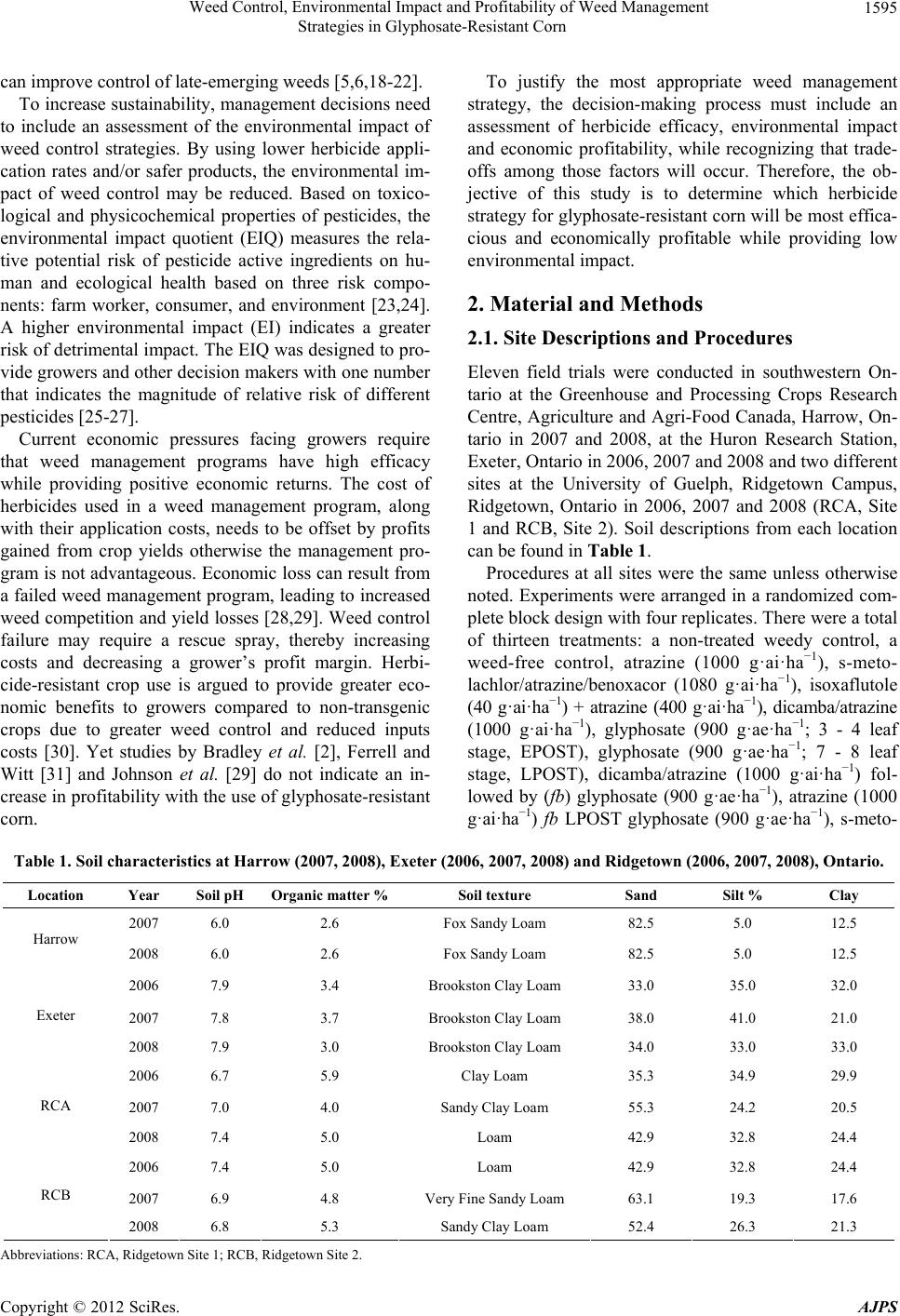 Weed Control, Environmental Impact and Profitability of Weed Management Strategies in Glyphosate-Resistant Corn 1595 can improve control of late-emerging weeds [5,6,18-22]. To increase sustainability, management decisions need to include an assessment of the environmental impact of weed control strategies. By using lower herbicide appli- cation rates and/or safer products, the environmental im- pact of weed control may be reduced. Based on toxico- logical and physicochemical properties of pesticides, the environmental impact quotient (EIQ) measures the rela- tive potential risk of pesticide active ingredients on hu- man and ecological health based on three risk compo- nents: farm worker, consumer, and environment [23,24]. A higher environmental impact (EI) indicates a greater risk of detrimental impact. The EIQ was designed to pro- vide growers and other decision makers with one number that indicates the magnitude of relative risk of different pesticides [25-27]. Current economic pressures facing growers require that weed management programs have high efficacy while providing positive economic returns. The cost of herbicides used in a weed management program, along with their application costs, needs to be offset by profits gained from crop yields otherwise the management pro- gram is not advantageous. Economic loss can result from a failed weed management program, leading to increased weed competition and yield losses [28,29]. Weed control failure may require a rescue spray, thereby increasing costs and decreasing a grower’s profit margin. Herbi- cide-resistant crop use is argued to provide greater eco- nomic benefits to growers compared to non-transgenic crops due to greater weed control and reduced inputs costs [30]. Yet studies by Bradley et al. [2], Ferrell and Witt [31] and Johnson et al. [29] do not indicate an in- crease in profitability with the use of glyphosate-resistant corn. To justify the most appropriate weed management strategy, the decision-making process must include an assessment of herbicide efficacy, environmental impact and economic profitability, while recognizing that trade- offs among those factors will occur. Therefore, the ob- jective of this study is to determine which herbicide strategy for glyphosate-resistant corn will be most effica- cious and economically profitable while providing low environmental impact. 2. Material and Methods 2.1. Site Descriptions and Procedures Eleven field trials were conducted in southwestern On- tario at the Greenhouse and Processing Crops Research Centre, Agriculture and Agri-Food Canada, Harrow, On- tario in 2007 and 2008, at the Huron Research Station, Exeter, Ontario in 2006, 2007 and 2008 and two different sites at the University of Guelph, Ridgetown Campus, Ridgetown, Ontario in 2006, 2007 and 2008 (RCA, Site 1 and RCB, Site 2). Soil descriptions from each location can be found in Table 1. Procedures at all sites were the same unless otherwise noted. Experiments were arranged in a randomized com- plete block design with four replicates. There were a total of thirteen treatments: a non-treated weedy control, a weed-free control, atrazine (1000 g·ai·ha−1), s-meto- lachlor/atrazine/benoxacor (1080 g·ai·ha−1), isoxaflutole (40 g·ai·ha−1) + atrazine (400 g·ai·ha−1), dicamba/atrazine (1000 g·ai·ha−1), glyphosate (900 g·ae·ha−1; 3 - 4 leaf stage, EPOST), glyphosate (900 g·ae·ha−1; 7 - 8 leaf stage, LPOST), dicamba/atrazine (1000 g·ai·ha−1) fol- lowed by (fb) glyphosate (900 g·ae·ha−1), atrazine (1000 g·ai·ha−1) fb LPOST glyphosate (900 g·ae·ha−1), s-meto- Table 1. Soil characteristics at Harrow (2007, 2008), Exeter (2006, 2007, 2008) and Ridgetown (2006, 2007, 2008), Ontario. Location Year Soil pH Organic matter %Soil texture Sand Silt % Clay 2007 6.0 2.6 Fox Sandy Loam 82.5 5.0 12.5 Harrow 2008 6.0 2.6 Fox Sandy Loam 82.5 5.0 12.5 2006 7.9 3.4 Brookston Clay Loam 33.0 35.0 32.0 2007 7.8 3.7 Brookston Clay Loam 38.0 41.0 21.0 Exeter 2008 7.9 3.0 Brookston Clay Loam 34.0 33.0 33.0 2006 6.7 5.9 Clay Loam 35.3 34.9 29.9 2007 7.0 4.0 Sandy Clay Loam 55.3 24.2 20.5 RCA 2008 7.4 5.0 Loam 42.9 32.8 24.4 2006 7.4 5.0 Loam 42.9 32.8 24.4 2007 6.9 4.8 Very Fine Sandy Loam 63.1 19.3 17.6 RCB 2008 6.8 5.3 Sandy Clay Loam 52.4 26.3 21.3 Abbreviations: RCA, Ridgetown Site 1; RCB, Ridgetown Site 2. Copyright © 2012 SciRes. AJPS 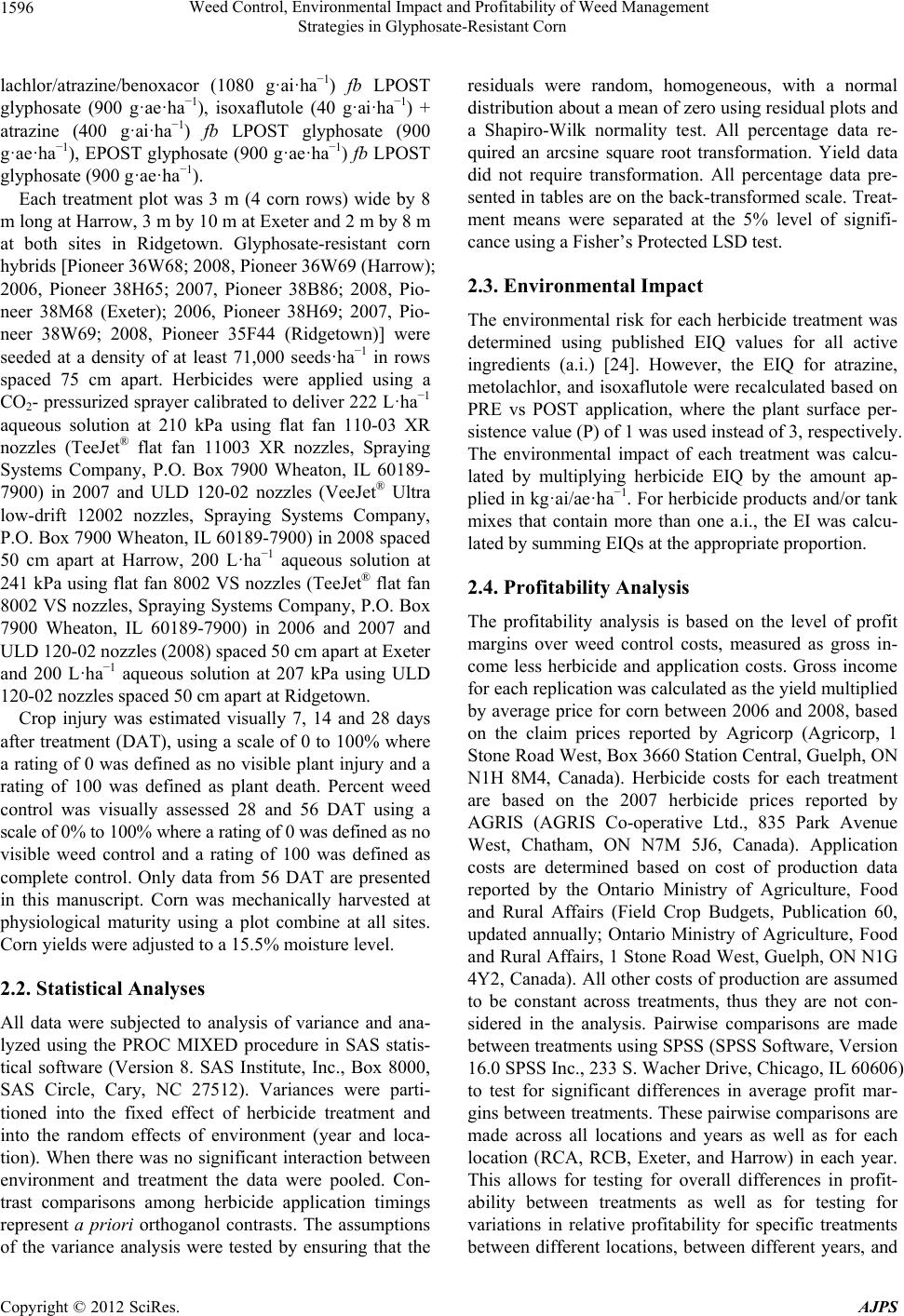 Weed Control, Environmental Impact and Profitability of Weed Management Strategies in Glyphosate-Resistant Corn 1596 lachlor/atrazine/benoxacor (1080 g·ai·ha−1) fb LPOST glyphosate (900 g·ae·ha−1), isoxaflutole (40 g·ai·ha−1) + atrazine (400 g·ai·ha−1) fb LPOST glyphosate (900 g·ae·ha−1), EPOST glyphosate (900 g·ae·ha−1) fb LPOST glyphosate (900 g·ae·ha−1). Each treatment plot was 3 m (4 corn rows) wide by 8 m long at Harrow, 3 m by 10 m at Exeter and 2 m by 8 m at both sites in Ridgetown. Glyphosate-resistant corn hybrids [Pioneer 36W68; 2008, Pioneer 36W69 (Harrow); 2006, Pioneer 38H65; 2007, Pioneer 38B86; 2008, Pio- neer 38M68 (Exeter); 2006, Pioneer 38H69; 2007, Pio- neer 38W69; 2008, Pioneer 35F44 (Ridgetown)] were seeded at a density of at least 71,000 seeds·ha−1 in rows spaced 75 cm apart. Herbicides were applied using a CO2- pressurized sprayer calibrated to deliver 222 L·ha−1 aqueous solution at 210 kPa using flat fan 110-03 XR nozzles (TeeJet® flat fan 11003 XR nozzles, Spraying Systems Company, P.O. Box 7900 Wheaton, IL 60189- 7900) in 2007 and ULD 120-02 nozzles (VeeJet® Ultra low-drift 12002 nozzles, Spraying Systems Company, P.O. Box 7900 Wheaton, IL 60189-7900) in 2008 spaced 50 cm apart at Harrow, 200 L·ha−1 aqueous solution at 241 kPa using flat fan 8002 VS nozzles (TeeJet® flat fan 8002 VS nozzles, Spraying Systems Company, P.O. Box 7900 Wheaton, IL 60189-7900) in 2006 and 2007 and ULD 120-02 nozzles (2008) spaced 50 cm apart at Exeter and 200 L·ha−1 aqueous solution at 207 kPa using ULD 120-02 nozzles spaced 50 cm apart at Ridgetown. Crop injury was estimated visually 7, 14 and 28 days after treatment (DAT), using a scale of 0 to 100% where a rating of 0 was defined as no visible plant injury and a rating of 100 was defined as plant death. Percent weed control was visually assessed 28 and 56 DAT using a scale of 0% to 100% where a rating of 0 was defined as no visible weed control and a rating of 100 was defined as complete control. Only data from 56 DAT are presented in this manuscript. Corn was mechanically harvested at physiological maturity using a plot combine at all sites. Corn yields were adjusted to a 15.5% moisture level. 2.2. Statistical Analyses All data were subjected to analysis of variance and ana- lyzed using the PROC MIXED procedure in SAS statis- tical software (Version 8. SAS Institute, Inc., Box 8000, SAS Circle, Cary, NC 27512). Variances were parti- tioned into the fixed effect of herbicide treatment and into the random effects of environment (year and loca- tion). When there was no significant interaction between environment and treatment the data were pooled. Con- trast comparisons among herbicide application timings represent a priori orthoganol contrasts. The assumptions of the variance analysis were tested by ensuring that the residuals were random, homogeneous, with a normal distribution about a mean of zero using residual plots and a Shapiro-Wilk normality test. All percentage data re- quired an arcsine square root transformation. Yield data did not require transformation. All percentage data pre- sented in tables are on the back-transformed scale. Treat- ment means were separated at the 5% level of signifi- cance using a Fisher’s Protected LSD test. 2.3. Environmental Impact The environmental risk for each herbicide treatment was determined using published EIQ values for all active ingredients (a.i.) [24]. However, the EIQ for atrazine, metolachlor, and isoxaflutole were recalculated based on PRE vs POST application, where the plant surface per- sistence value (P) of 1 was used instead of 3, respectively. The environmental impact of each treatment was calcu- lated by multiplying herbicide EIQ by the amount ap- plied in kg·ai/ae·ha−1. For herbicide products and/or tank mixes that contain more than one a.i., the EI was calcu- lated by summing EIQs at the appropriate proportion. 2.4. Profitability Analysis The profitability analysis is based on the level of profit margins over weed control costs, measured as gross in- come less herbicide and application costs. Gross income for each replication was calculated as the yield multiplied by average price for corn between 2006 and 2008, based on the claim prices reported by Agricorp (Agricorp, 1 Stone Road West, Box 3660 Station Central, Guelph, ON N1H 8M4, Canada). Herbicide costs for each treatment are based on the 2007 herbicide prices reported by AGRIS (AGRIS Co-operative Ltd., 835 Park Avenue West, Chatham, ON N7M 5J6, Canada). Application costs are determined based on cost of production data reported by the Ontario Ministry of Agriculture, Food and Rural Affairs (Field Crop Budgets, Publication 60, updated annually; Ontario Ministry of Agriculture, Food and Rural Affairs, 1 Stone Road West, Guelph, ON N1G 4Y2, Canada). All other costs of production are assumed to be constant across treatments, thus they are not con- sidered in the analysis. Pairwise comparisons are made between treatments using SPSS (SPSS Software, Version 16.0 SPSS Inc., 233 S. Wacher Drive, Chicago, IL 60606) to test for significant differences in average profit mar- gins between treatments. These pairwise comparisons are made across all locations and years as well as for each location (RCA, RCB, Exeter, and Harrow) in each year. This allows for testing for overall differences in profit- ability between treatments as well as for testing for variations in relative profitability for specific treatments between different locations, between different years, and Copyright © 2012 SciRes. AJPS 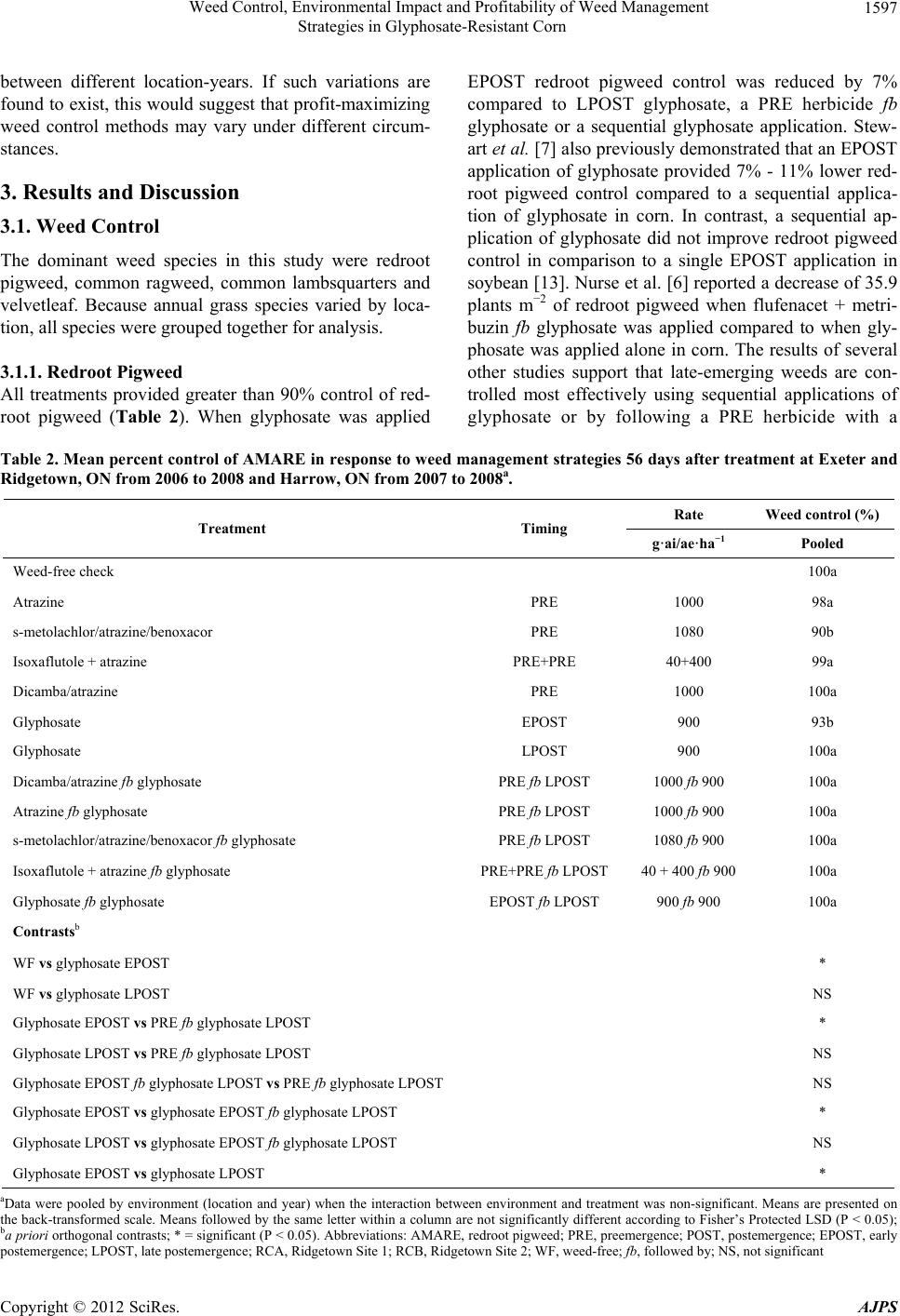 Weed Control, Environmental Impact and Profitability of Weed Management Strategies in Glyphosate-Resistant Corn 1597 between different location-years. If such variations are found to exist, this would suggest that profit-maximizing weed control methods may vary under different circum- stances. 3. Results and Discussion 3.1. Weed Control The dominant weed species in this study were redroot pigweed, common ragweed, common lambsquarters and velvetleaf. Because annual grass species varied by loca- tion, all species were grouped together for analysis. 3.1.1. Redroot Pigweed All treatments provided greater than 90% control of red- root pigweed (Table 2). When glyphosate was applied EPOST redroot pigweed control was reduced by 7% compared to LPOST glyphosate, a PRE herbicide fb glyphosate or a sequential glyphosate application. Stew- art et al. [7] also previously demonstrated that an EPOST application of glyphosate provided 7% - 11% lower red- root pigweed control compared to a sequential applica- tion of glyphosate in corn. In contrast, a sequential ap- plication of glyphosate did not improve redroot pigweed control in comparison to a single EPOST application in soybean [13]. Nurse et al. [6] reported a decrease of 35.9 plants m−2 of redroot pigweed when flufenacet + metri- buzin fb glyphosate was applied compared to when gly- phosate was applied alone in corn. The results of several other studies support that late-emerging weeds are con- trolled most effectively using sequential applications of glyphosate or by following a PRE herbicide with a Table 2. Mean percent control of AMARE in response to weed management strategies 56 days after treatment at Exeter and Ridgetown, ON from 2006 to 2008 and Harrow, ON from 2007 to 2008a. Rate Weed control (%) Treatment Timing g·ai/ae·ha−1 Pooled Weed-free check 100a Atrazine PRE 1000 98a s-metolachlor/atrazine/benoxacor PRE 1080 90b Isoxaflutole + atrazine PRE+PRE 40+400 99a Dicamba/atrazine PRE 1000 100a Glyphosate EPOST 900 93b Glyphosate LPOST 900 100a Dicamba/atrazine fb glyphosate PRE fb LPOST 1000 fb 900 100a Atrazine fb glyphosate PRE fb LPOST 1000 fb 900 100a s-metolachlor/atrazine/benoxacor fb glyphosate PRE fb LPOST 1080 fb 900 100a Isoxaflutole + atrazine fb glyphosate PRE+PRE fb LPOST 40 + 400 fb 900 100a Glyphosate fb glyphosate EPOST fb LPOST 900 fb 900 100a Contrastsb WF vs glyphosate EPOST * WF vs glyphosate LPOST NS Glyphosate EPOST vs PRE fb glyphosate LPOST * Glyphosate LPOST vs PRE fb glyphosate LPOST NS Glyphosate EPOST fb glyphosate LPOST vs PRE fb glyphosate LPOST NS Glyphosate EPOST vs glyphosate EPOST fb glyphosate LPOST * Glyphosate LPOST vs glyphosate EPOST fb glyphosate LPOST NS Glyphosate EPOST vs glyphosate LPOST * aData were pooled by environment (location and year) when the interaction between environment and treatment was non-significant. Means are presented on the back-transformed scale. Means followed by the same letter within a column are not significantly different according to Fisher’s Protected LSD (P < 0.05); ba priori orthogonal contrasts; * = significant (P < 0.05). Abbreviations: AMARE, redroot pigweed; PRE, preemergence; POST, postemergence; EPOST, early ostemergence; LPOST, late postemergence; RCA, Ridgetown Site 1; RCB, Ridgetown Site 2; WF, weed-free; fb, followed by; NS, not significant p Copyright © 2012 SciRes. AJPS 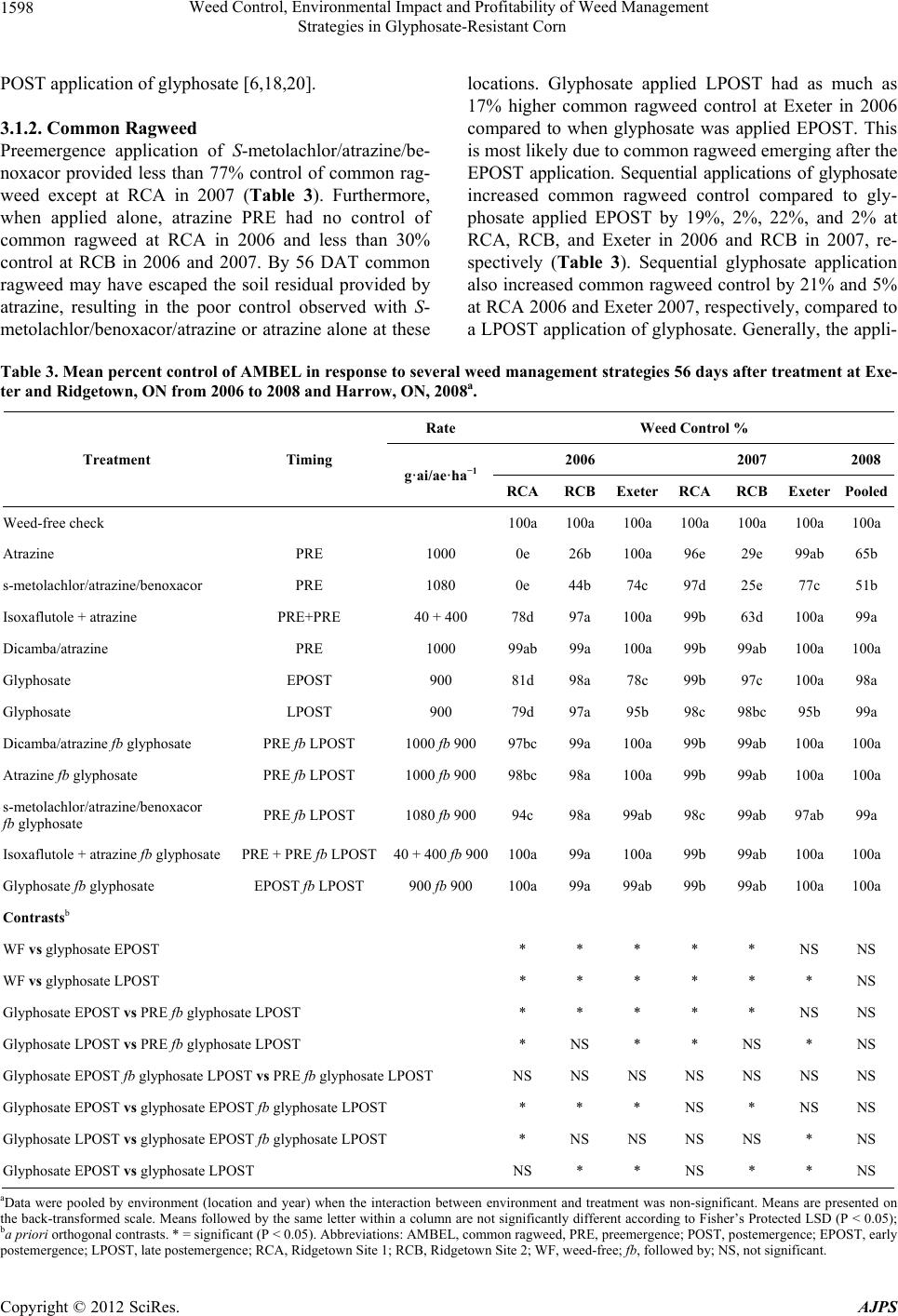 Weed Control, Environmental Impact and Profitability of Weed Management Strategies in Glyphosate-Resistant Corn 1598 POST application of glyphosate [6,18,20]. 3.1.2. Common Ragweed Preemergence application of S-metolachlor/atrazine/be- noxacor provided less than 77% control of common rag- weed except at RCA in 2007 (Table 3). Furthermore, when applied alone, atrazine PRE had no control of common ragweed at RCA in 2006 and less than 30% control at RCB in 2006 and 2007. By 56 DAT common ragweed may have escaped the soil residual provided by atrazine, resulting in the poor control observed with S- metolachlor/benoxacor/atrazine or atrazine alone at these locations. Glyphosate applied LPOST had as much as 17% higher common ragweed control at Exeter in 2006 compared to when glyphosate was applied EPOST. This is most likely due to common ragweed emerging after the EPOST application. Sequential applications of glyphosate increased common ragweed control compared to gly- phosate applied EPOST by 19%, 2%, 22%, and 2% at RCA, RCB, and Exeter in 2006 and RCB in 2007, re- spectively (Table 3). Sequential glyphosate application also increased common ragweed control by 21% and 5% at RCA 2006 and Exeter 2007, respectively, compared to a LPOST application of glyphosate. Generally, the appli- Table 3. Mean percent control of AMBEL in response to several weed management strategies 56 days after treatment at Exe- ter and Ridgetown, ON from 2006 to 2008 and Harrow, ON, 2008a. Rate Weed Control % 2006 2007 2008 Treatment Timing g·ai/ae·ha−1 RCA RCBExeterRCA RCB ExeterPooled Weed-free check 100a100a100a100a 100a 100a100a Atrazine PRE 1000 0e 26b 100a96e 29e 99ab65b s-metolachlor/atrazine/benoxacor PRE 1080 0e 44b 74c 97d 25e 77c 51b Isoxaflutole + atrazine PRE+PRE 40 + 400 78d 97a 100a99b 63d 100a99a Dicamba/atrazine PRE 1000 99ab99a 100a99b 99ab 100a100a Glyphosate EPOST 900 81d 98a 78c 99b 97c 100a98a Glyphosate LPOST 900 79d 97a 95b 98c 98bc 95b 99a Dicamba/atrazine fb glyphosate PRE fb LPOST 1000 fb 900 97bc 99a 100a 99b 99ab 100a100a Atrazine fb glyphosate PRE fb LPOST 1000 fb 900 98bc98a 100a99b 99ab 100a100a s-metolachlor/atrazine/benoxacor f b glyphosate PRE fb LPOST 1080 fb 900 94c 98a 99ab98c 99ab 97ab 99a Isoxaflutole + atrazine fb glyphosatePRE + PRE fb LPOST40 + 400 fb 900100a99a 100a99b 99ab 100a100a Glyphosate fb glyphosate EPOST fb LPOST 900 fb 900 100a99a 99ab99b 99ab 100a100a Contrastsb WF vs glyphosate EPOST * * * * * NS NS WF vs glyphosate LPOST * * * * * * NS Glyphosate EPOST vs PRE fb glyphosate LPOST * * * * * NS NS Glyphosate LPOST vs PRE fb glyphosate LPOST * NS * * NS * NS Glyphosate EPOST fb glyphosate LPOST vs PRE fb glyphosate LPOST NS NS NS NS NS NS NS Glyphosate EPOST vs glyphosate EPOST fb glyphosate LPOST * * * NS * NS NS Glyphosate LPOST vs glyphosate EPOST fb glyphosate LPOST * NS NS NS NS * NS Glyphosate EPOST vs glyphosate LPOST NS * * NS * * NS aData were pooled by environment (location and year) when the interaction between environment and treatment was non-significant. Means are presented on the back-transformed scale. Means followed by the same letter within a column are not significantly different according to Fisher’s Protected LSD (P < 0.05); ba priori orthogonal contrasts. * = significant (P < 0.05). Abbreviations: AMBEL, common ragweed, PRE, preemergence; POST, postemergence; EPOST, early ostemergence; LPOST, late postemergence; RCA, Ridgetown Site 1; RCB, Ridgetown Site 2; WF, weed-free; fb, followed by; NS, not significant. p Copyright © 2012 SciRes. AJPS 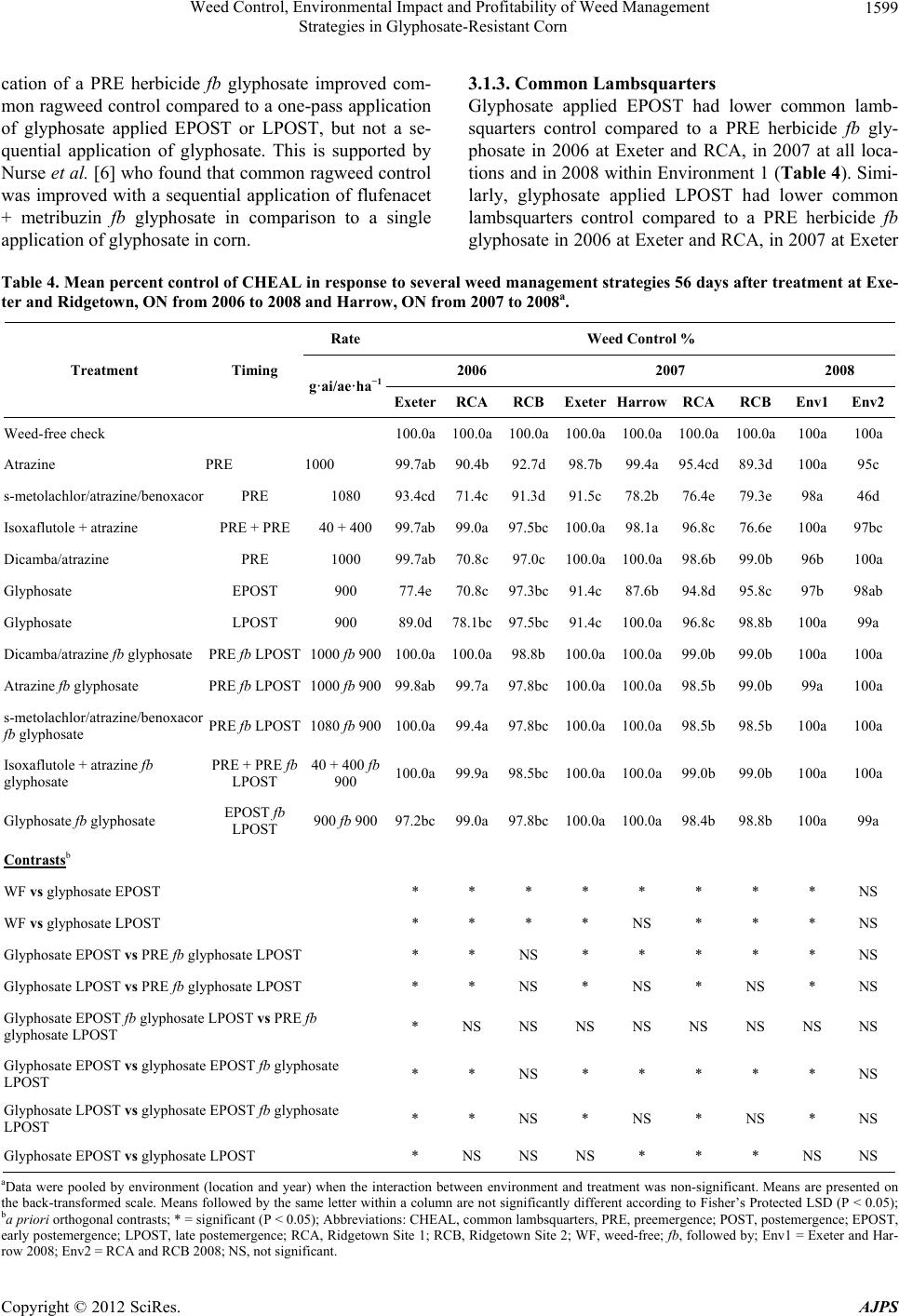 Weed Control, Environmental Impact and Profitability of Weed Management Strategies in Glyphosate-Resistant Corn 1599 cation of a PRE herbicide fb glyphosate improved com- mon ragweed control compared to a one-pass application of glyphosate applied EPOST or LPOST, but not a se- quential application of glyphosate. This is supported by Nurse et al. [6] who found that common ragweed control was improved with a sequential application of flufenacet + metribuzin fb glyphosate in comparison to a single application of glyphosate in corn. 3.1.3. Common Lambsquarters Glyphosate applied EPOST had lower common lamb- squarters control compared to a PRE herbicide fb gly- phosate in 2006 at Exeter and RCA, in 2007 at all loca- tions and in 2008 within Environment 1 (Table 4). Simi- larly, glyphosate applied LPOST had lower common lambsquarters control compared to a PRE herbicide fb glyphosate in 2006 at Exeter and RCA, in 2007 at Exeter Table 4. Mean percent control of CHEAL in response to several weed management strategies 56 days after treatment at Exe- ter and Ridgetown, ON from 2006 to 2008 and Harrow, ON from 2007 to 2008a. Rate Weed Control % 2006 2007 2008 Treatment Timing g·ai/ae·ha−1 ExeterRCARCBExeterHarrowRCA RCB Env1Env2 Weed-free check 100.0a100.0a100.0a100.0a100.0a100.0a 100.0a 100a100a Atrazine PRE 1000 99.7ab90.4b92.7d98.7b99.4a95.4cd 89.3d 100a95c s-metolachlor/atrazine/benoxacor PRE 1080 93.4cd71.4c91.3d 91.5c78.2b 76.4e 79.3e 98a 46d Isoxaflutole + atrazine PRE + PRE 40 + 400 99.7ab99.0a97.5bc100.0a98.1a 96.8c 76.6e 100a97bc Dicamba/atrazine PRE 1000 99.7ab70.8c97.0c100.0a100.0a98.6b 99.0b 96b 100a Glyphosate EPOST 900 77.4e70.8c97.3bc91.4c87.6b94.8d 95.8c 97b 98ab Glyphosate LPOST 900 89.0d78.1bc97.5bc91.4c100.0a96.8c 98.8b 100a99a Dicamba/atrazine fb glyphosate PRE fb LPOST 1000 fb 900100.0a100.0a98.8b100.0a100.0a99.0b 99.0b 100a100a Atrazine fb glyphosate PRE fb LPOST 1000 fb 90099.8ab99.7a97.8bc100.0a100.0a98.5b 99.0b 99a 100a s-metolachlor/atrazine/benoxacor f b glyphosate PRE fb LPOST 1080 fb 900100.0a99.4a97.8bc100.0a100.0a98.5b 98.5b 100a100a Isoxaflutole + atrazine fb glyphosate PRE + PRE fb LPOST 40 + 400 fb 900 100.0a99.9a98.5bc100.0a100.0a99.0b 99.0b 100a100a Glyphosate fb glyphosate EPOST fb LPOST 900 fb 90097.2bc99.0a97.8bc100.0a100.0a98.4b 98.8b 100a99a Contrastsb WF vs glyphosate EPOST * * * * * * * * NS WF vs glyphosate LPOST * * * * NS * * * NS Glyphosate EPOST vs PRE fb glyphosate LPOST * * NS * * * * * NS Glyphosate LPOST vs PRE fb glyphosate LPOST * * NS * NS * NS * NS Glyphosate EPOST fb glyphosate LPOST vs PRE fb glyphosate LPOST * NS NS NS NS NS NS NS NS Glyphosate EPOST vs glyphosate EPOST fb glyphosate LPOST * * NS * * * * * NS Glyphosate LPOST vs glyphosate EPOST fb glyphosate LPOST * * NS * NS * NS * NS Glyphosate EPOST vs glyphosate LPOST * NS NS NS * * * NS NS aData were pooled by environment (location and year) when the interaction between environment and treatment was non-significant. Means are presented on the back-transformed scale. Means followed by the same letter within a column are not significantly different according to Fisher’s Protected LSD (P < 0.05); ba priori orthogonal contrasts; * = significant (P < 0.05); Abbreviations: CHEAL, common lambsquarters, PRE, preemergence; POST, postemergence; EPOST, early postemergence; LPOST, late postemergence; RCA, Ridgetown Site 1; RCB, Ridgetown Site 2; WF, weed-free; fb, followed by; Env1 = Exeter and Har- ow 2008; Env2 = RCA and RCB 2008; NS, not significant. r Copyright © 2012 SciRes. AJPS 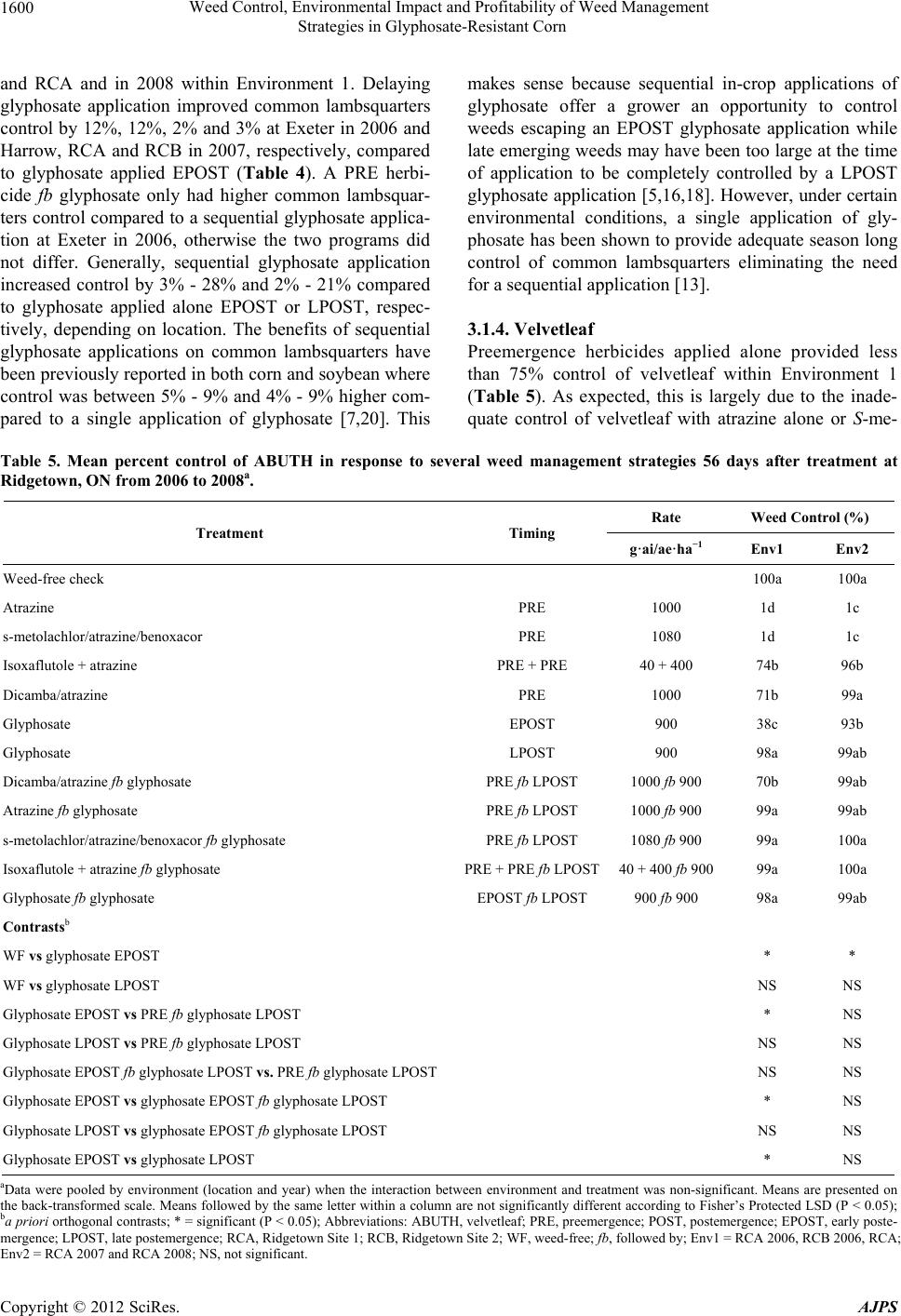 Weed Control, Environmental Impact and Profitability of Weed Management Strategies in Glyphosate-Resistant Corn 1600 and RCA and in 2008 within Environment 1. Delaying glyphosate application improved common lambsquarters control by 12%, 12%, 2% and 3% at Exeter in 2006 and Harrow, RCA and RCB in 2007, respectively, compared to glyphosate applied EPOST (Table 4). A PRE herbi- cide fb glyphosate only had higher common lambsquar- ters control compared to a sequential glyphosate applica- tion at Exeter in 2006, otherwise the two programs did not differ. Generally, sequential glyphosate application increased control by 3% - 28% and 2% - 21% compared to glyphosate applied alone EPOST or LPOST, respec- tively, depending on location. The benefits of sequential glyphosate applications on common lambsquarters have been previously reported in both corn and soybean where control was between 5% - 9% and 4% - 9% higher com- pared to a single application of glyphosate [7,20]. This makes sense because sequential in-crop applications of glyphosate offer a grower an opportunity to control weeds escaping an EPOST glyphosate application while late emerging weeds may have been too large at the time of application to be completely controlled by a LPOST glyphosate application [5,16,18]. However, under certain environmental conditions, a single application of gly- phosate has been shown to provide adequate season long control of common lambsquarters eliminating the need for a sequential application [13]. 3.1.4. Velvetleaf Preemergence herbicides applied alone provided less than 75% control of velvetleaf within Environment 1 (Table 5). As expected, this is largely due to the inade- quate control of velvetleaf with atrazine alone or S-me- Table 5. Mean percent control of ABUTH in response to several weed management strategies 56 days after treatment at Ridgetown, ON from 2006 to 2008a. Rate Weed Control (%) Treatment Timing g·ai/ae·ha−1 Env1 Env2 Weed-free check 100a 100a Atrazine PRE 1000 1d 1c s-metolachlor/atrazine/benoxacor PRE 1080 1d 1c Isoxaflutole + atrazine PRE + PRE 40 + 400 74b 96b Dicamba/atrazine PRE 1000 71b 99a Glyphosate EPOST 900 38c 93b Glyphosate LPOST 900 98a 99ab Dicamba/atrazine fb glyphosate PRE fb LPOST 1000 fb 900 70b 99ab Atrazine fb glyphosate PRE fb LPOST 1000 fb 900 99a 99ab s-metolachlor/atrazine/benoxacor fb glyphosate PRE fb LPOST 1080 fb 900 99a 100a Isoxaflutole + atrazine fb glyphosate PRE + PRE fb LPOST40 + 400 fb 900 99a 100a Glyphosate fb glyphosate EPOST fb LPOST 900 fb 900 98a 99ab Contrastsb WF vs glyphosate EPOST * * WF vs glyphosate LPOST NS NS Glyphosate EPOST vs PRE fb glyphosate LPOST * NS Glyphosate LPOST vs PRE fb glyphosate LPOST NS NS Glyphosate EPOST fb glyphosate LPOST vs. PRE fb glyphosate LPOST NS NS Glyphosate EPOST vs glyphosate EPOST fb glyphosate LPOST * NS Glyphosate LPOST vs glyphosate EPOST fb glyphosate LPOST NS NS Glyphosate EPOST vs glyphosate LPOST * NS aData were pooled by environment (location and year) when the interaction between environment and treatment was non-significant. Means are presented on the back-transformed scale. Means followed by the same letter within a column are not significantly different according to Fisher’s Protected LSD (P < 0.05); ba priori orthogonal contrasts; * = significant (P < 0.05); Abbreviations: ABUTH, velvetleaf; PRE, preemergence; POST, postemergence; EPOST, early poste- mergence; LPOST, late postemergence; RCA, Ridgetown Site 1; RCB, Ridgetown Site 2; WF, weed-free; fb, followed by; Env1 = RCA 2006, RCB 2006, RCA; nv2 = RCA 2007 and RCA 2008; NS, not significant. E Copyright © 2012 SciRes. AJPS  Weed Control, Environmental Impact and Profitability of Weed Management Strategies in Glyphosate-Resistant Corn 1601 tolachlor/atrazine/benoxacor [32]; highlighted by the 1% control within both environments. Glyphosate applied EPOST within Environment 1 also provided limited con- trol of velvetleaf (38%). Percent control was improved when glyphosate was preceded by a PRE herbicide. Se- quential application of glyphosate or glyphosate applied LPOST both provided 60% better control of velvetleaf compared to a single glyphosate application EPOST in Environment1. This is supported by Gonzini et al. [20] who demonstrated that velvetleaf control was improved by 13% - 22% and 17% - 27% when PRE herbicides were followed by glyphosate or sequential applications of glyphosate were applied, respectively, compared to a single application of glyphosate. 3.1.5. Annual Grasses Preemergence herbicides fb glyphosate provided greater control of annual grasses than glyphosate applied EPOST at Exeter and RCB in 2006, Exeter and Harrow in 2007, and Harrow, RCA and RCB in 2008; or glyphosate ap- plied LPOST at Exeter in 2007 (Table 6). Residual con- trol from the PRE herbicide in addition to a LPOST cleanup with glyphosate likely contributed to the in- creased annual grass control. Annual grass control was higher when PRE herbicides were followed by gly- phosate compared to sequential glyphosate applications at Exeter in 2008; however this relationship was reversed at Harrow in 2007 and 2008. The only non-glyphosate treatments expected to control annual grasses were S-me- tolachlor/atrazine/benoxacor and isoxaflutole + atrazine. Comparison of these treatments to a sequential gly- phosate application showed no differences at Harrow (2007, 2008) and had higher control at Exeter in 2008. Control of annual grasses increased by 11% - 70% and 6% - 9% with sequential glyphosate applications com- pared to glyphosate applied alone EPOST or LPOST, respectively, depending on location (Table 6). As sug- gested previously, EPOST glyphosate applications alone may result in weed escapes and LPOST glyphosate ap- plications alone may not control larger weeds. Applica- tion of glyphosate LPOST provided 11% - 64% greater control of annual grasses compared to EPOST applica- tion; however, this response was location dependent. Gonzini et al. [20] found that in glyphosate-resistant soy- bean control of giant foxtail improved by 2% - 15% with sequential applications of glyphosate POST or PRE her- bicides followed by a POST application of glyphosate compared to a single-pass application of glyphosate POST. 3.2. Crop Injury and Yield There was no visual crop injury at 7 and 28 DAT for all treatments in this study (data not shown). At most loca- tions, PRE herbicides fb glyphosate resulted in higher yields than when glyphosate was applied alone LPOST (Table 7). Nurse et al. [6] demonstrated that corn yield increased when a PRE herbicide (flufenacet + metribuzin) was fb glyphosate compared to glyphosate alone. They attributed this response to early season weed control. In our study, sequential applications of glyphosate also had higher corn yield by up to 1.9 MT·ha−1 compared to gly- phosate applied LPOST at most locations. We attribute these higher yields to increased weed control. There was no difference in corn yield between glyphosate applied EPOST and sequential glyphosate applications; however, when glyphosate was applied EPOST yield increased by 1.7 MT·ha−1 compared to glyphosate applied LPOST at Exeter in 2007. Greater control of common ragweed contributed to higher corn yield at this location with glyphosate applied EPOST. In contrast, glyphosate ap- plied EPOST reduced yield by 1.1 MT·ha−1 compared to glyphosate applied LPOST at RCB in 2008. Again, we attributed this to a decrease in weed control. At all other locations, there was no difference in corn yield between EPOST and LPOST glyphosate. 3.3. Environmental Impact The type of application impacts the EIQ of a pesticide. Kovach et al. [23] considered that all POST herbicides have a greater risk due to plant surface persistence, which factors into the farm worker, consumer and envi- ronmental components of the EIQ calculation. The EIQ of PRE applied atrazine, metolachlor, and isoxaflutole (Table 8) were on average 8.8 lower than the same her- bicide applied POST. With approximately an order of magnitude difference in the EIQ, it is critical to consider the type of application when evaluating the relative risk of weed control strategies. The lowest EI of 6.0 was atrazine + isoxaflutole, due to the low application rate. In contrast, due to higher EIQ values, the highest EI of herbicide products applied alone was atrazine + dicamba at 24.6. Clearly, adding another active ingredient to the weed management strategy will increase the EI, but for all treatments other than atrazine + isoxaflutole, adding glyphosate less than doubles the EI. For atrazine + isoxaflutole the addition of glyphosate more than triples the EI. Sequential glyphosate applications had a higher EI than all products applied alone and atrazine + isoxaflu- tole fb glyphosate. The EI of applying glyphosate twice was equivalent to applying atrazine + dicamba alone, atrazine fb glyphosate, atrazine + metolachlor fb gly- phosate and atrazine + isoxaflutole fb glyphosate. Thus, the addition of the aforementioned PRE herbicides to Copyright © 2012 SciRes. AJPS  Weed Control, Environmental Impact and Profitability of Weed Management Strategies in Glyphosate-Resistant Corn 1602 Table 6. Mean percent control of annual grasses in response to several weed management strategies 56 days after treatment at Exeter and Ridgetown, ON from 2006 to 2008 and Harrow, ON from 2007 to 2008a. Rate Weed Control % 2006 2007 2008 Treatment Timing g·ai/ae·ha−1 ExeterRCBExeter HarrowRCARCBExeter Harrow RCARCB Weed-free check 100a100a 100a 100a 100a 100a 100a 100a 100a 100a Atrazine PRE 1000 0d 72.9f0e 0d 65.4d0d 40e 1d 1f 78d s-metolachlor/atrazine/ benoxacor PRE 1080 71.1b91.4de60.1d6.1d 95.6b0.8b 99ab 30c 55e 81d Isoxaflutole + atrazine PRE + PRE40 + 400 97.4a93.1cde95.5abc76.6b95.8b0b 99ab 1d 96bc94c Dicamba/atrazine PRE 1000 0d 68.9f0e 2.8d 82.1c11.0d1f 2d 1f 1e Glyphosate EPOST 900 48.9bc87.0e84.0c45.0c97.0b97.3bc98abc 30c 75d 98b Glyphosate LPOST 900 98.1a98.1abc90.6c100a98.8ab99.0ab94cd 94b 99ab99ab Dicamba/atrazine fb glyphosate PRE fb LPOST 1000 fb 900 39.9c97.6bcd 91.7bc71.4b98.3b93.8c95bcd 45c 92c 99ab Atrazine fb glyphosate PRE fb LPOST 1000 fb 900 99.7a97.8bc100a 80.2b98.8ab98.8abc92d 93b 99ab100a s-metolachlor/atrazine/ benoxacor fb glyphosate PRE fb LPOST 1080 fb 900 99.0a98.1abc100a 95.6a98.8ab98.5abc100a 100a 99ab 100a Isoxaflutole + atrazine f b glyphosate PRE + PRE fb LPOST 40 + 400 fb 900 100a98.8ab100a 96.8a98.8ab98.0abc100a 93b 99ab100a Glyphosate fb glyphosate EPOST fb LPOST 900 fb 900 98.0a97.8bc99.8ab100a98.6b98.8abc92d 100a 98ab99ab Contrastsb WF vs glyphosate EPOST * * * * * * NS * * * WF vs glyphosate LPOST NS NS * NS NS NS * * NS NS Glyphosate EPOST vs PRE fb glyphosate LPOST * * * * NS NS NS * * * Glyphosate LPOST vs PRE fb glyphosate LPOST NS NS * * NS NS NS NS NS NS Glyphosate EPOST fb glyphosate LPOST vs PRE f b glyphosate LPOST NS NS NS * NS NS * * NS NS Glyphosate EPOST vs glyphosate EPOST fb glyphosate LPOST * * * * NS NS * * * NS Glyphosate LPOST vs glyphosate EPOST fb glyphosate LPOST NS NS * NS NS NS NS * NS NS Glyphosate EPOST vs glyphosate LPOST * * NS * NS NS NS * * NS aData were pooled by environment (location and year) when the interaction between environment and treatment was non-significant. Means are presented on the back-transformed scale. Means followed by the same letter within a column are not significantly different according to Fisher’s Protected LSD (P < 0.05). ba priori orthogonal contrasts. * = significant (P < 0.05); Abbreviations: PRE, preemergence; POST, postemergence; EPOST, early postemergence; LPOST, late postemergence; WF, weed-free; fb, followed by; RCA, Ridgetown Site 1; RCB, Ridgetown Site 2; NS, not significant. Copyright © 2012 SciRes. AJPS 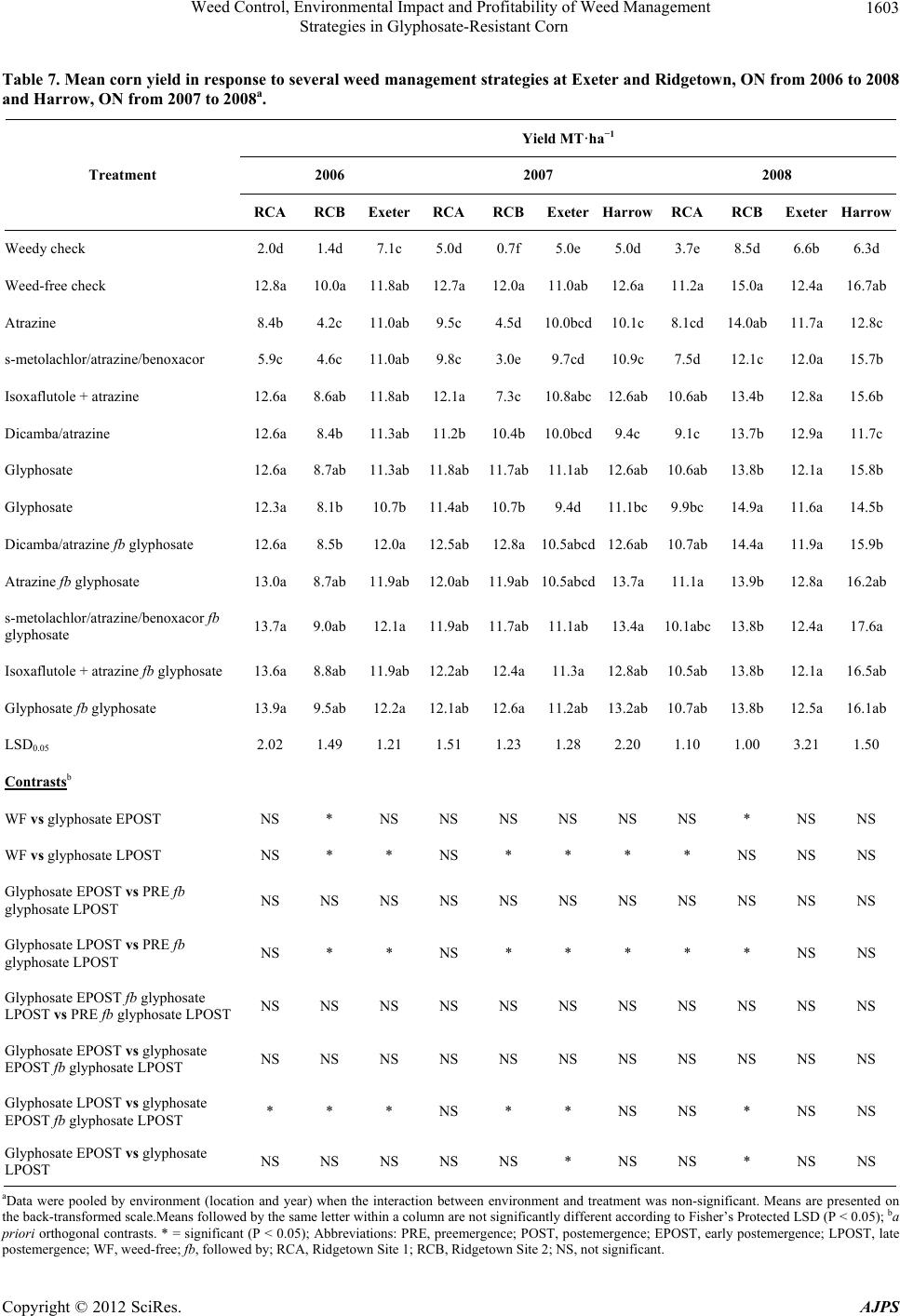 Weed Control, Environmental Impact and Profitability of Weed Management Strategies in Glyphosate-Resistant Corn 1603 Table 7. Mean corn yield in response to several weed management strategies at Exeter and Ridgetown, ON from 2006 to 2008 and Harrow, ON from 2007 to 2008a. Yield MT·ha−1 2006 2007 2008 Treatment RCA RCB ExeterRCARCBExeterHarrowRCA RCB ExeterHarrow Weedy check 2.0d 1.4d 7.1c 5.0d 0.7f 5.0e 5.0d 3.7e 8.5d 6.6b 6.3d Weed-free check 12.8a 10.0a 11.8ab12.7a12.0a11.0ab12.6a 11.2a 15.0a 12.4a16.7ab Atrazine 8.4b 4.2c 11.0ab9.5c 4.5d 10.0bcd10.1c8.1cd 14.0ab 11.7a12.8c s-metolachlor/atrazine/benoxacor 5.9c 4.6c 11.0ab9.8c 3.0e 9.7cd10.9c7.5d 12.1c 12.0a15.7b Isoxaflutole + atrazine 12.6a 8.6ab 11.8ab12.1a7.3c 10.8abc12.6ab10.6ab 13.4b 12.8a15.6b Dicamba/atrazine 12.6a 8.4b 11.3ab11.2b10.4b10.0bcd9.4c 9.1c 13.7b 12.9a11.7c Glyphosate 12.6a 8.7ab 11.3ab11.8ab11.7ab11.1ab12.6ab10.6ab 13.8b 12.1a15.8b Glyphosate 12.3a 8.1b 10.7b11.4ab10.7b9.4d 11.1bc9.9bc 14.9a 11.6a14.5b Dicamba/atrazine fb glyphosate 12.6a 8.5b 12.0a12.5ab12.8a10.5abcd12.6ab10.7ab 14.4a 11.9a15.9b Atrazine fb glyphosate 13.0a 8.7ab 11.9ab12.0ab11.9ab10.5abcd13.7a11.1a 13.9b 12.8a16.2ab s-metolachlor/atrazine/benoxacor fb glyphosate 13.7a 9.0ab 12.1a11.9ab11.7ab11.1ab13.4a 10.1abc 13.8b 12.4a17.6a Isoxaflutole + atrazine fb glyphosate 13.6a 8.8ab 11.9ab12.2ab12.4a11.3a 12.8ab10.5ab 13.8b 12.1a16.5ab Glyphosate fb glyphosate 13.9a 9.5ab 12.2a12.1ab12.6a 11.2ab13.2ab10.7ab 13.8b 12.5a16.1ab LSD0.05 2.02 1.49 1.21 1.51 1.23 1.28 2.20 1.10 1.00 3.21 1.50 Contrastsb WF vs glyphosate EPOST NS * NS NS NS NS NS NS * NS NS WF vs glyphosate LPOST NS * * NS * * * * NS NS NS Glyphosate EPOST vs PRE fb glyphosate LPOST NS NS NS NS NS NS NS NS NS NS NS Glyphosate LPOST vs PRE fb glyphosate LPOST NS * * NS * * * * * NS NS Glyphosate EPOST fb glyphosate LPOST vs PRE fb glyphosate LPOST NS NS NS NS NS NS NS NS NS NS NS Glyphosate EPOST vs glyphosate EPOST fb glyphosate LPOST NS NS NS NS NS NS NS NS NS NS NS Glyphosate LPOST vs glyphosate EPOST fb glyphosate LPOST * * * NS * * NS NS * NS NS Glyphosate EPOST vs glyphosate LPOST NS NS NS NS NS * NS NS * NS NS aData were pooled by environment (location and year) when the interaction between environment and treatment was non-significant. Means are presented on the back-transformed scale.Means followed by the same letter within a column are not significantly different according to Fisher’s Protected LSD (P < 0.05); ba priori orthogonal contrasts. * = significant (P < 0.05); Abbreviations: PRE, preemergence; POST, postemergence; EPOST, early postemergence; LPOST, late postemergence; WF, weed-free; fb, followed by; RCA, Ridgetown Site 1; RCB, Ridgetown Site 2; NS, not significant. Copyright © 2012 SciRes. AJPS  Weed Control, Environmental Impact and Profitability of Weed Management Strategies in Glyphosate-Resistant Corn Copyright © 2012 SciRes. AJPS 1604 Table 8. Environmental impact quotient (EIQ) and environmental impact (EI) of weed management strategies used at Exeter and Ridgetown, ON from 2006 to 2008 and Harrow, ON from 2007 to 2008. Active ingredient(s) Timing Individual EIQ valuesa Product Rate g·ai/ae·ha−1 EIb Atrazine PRE 13.6 1000 13.6 s-metolachlor/atrazine/benoxacor PRE 14.2/13.6 1080 15.0 Atrazine + isoxaflutole PRE 13.6/13.3 440 6.0 Dicamba/atrazine PRE 22.9/28.0 1000 24.6 Glyphosate EPOST 15.3 900 13.8 Glyphosate LPOST 900 13.8 Dicamba/atrazine fb glyphosate PRE fb LPOST 1000 fb 900 38.4 Atrazine fb glyphosate PRE fb LPOST 1000 fb 900 27.4 s-metolachlor/atrazine/benoxacor fb glyphosate PRE fb LPOST 1080 fb 900 28.8 Atrazine + isoxaflutole fb glyphosate PRE fb LPOST 440 fb 900 19.8 Glyphosate fb glyphosate EPOST fb LPOST 1800 27.5 aEIQ values for each a.i. obtained from Kovach et al. (1999), except for atrazine, metolachlor, and isoxaflutole which were calculated according to formula developed by Kovach et al. (1992) using PRE vs POST application; bEI values for products with more than one a.i. were obtained by summing the relative proportion of each a.i.; Abbreviations: EPOST, early postemergence; LPOST, late postemergence; fb, followed by; EIQ, environmental impact quotient; EI, environmental impact. glyphosate-resistant corn production is strongly recom- mended based on equivalent environmental risk as well as resistance management. 3.4. Profitability Analysis The results of the profitability analysis indicate that across all locations and years no significant differences in profit margins exist between the following treatments: isoxaflutole + atrazine, glyphosate EPOST, glyphosate LPOST, dicamba/atrazine followed by (fb) glyphosate, atrazine fb glyphosate, S-metolachlor/atrazine/benoxacor fb glyphosate, isoxaflutole + atrazine fb glyphosate and sequential applications of glyphosate (Table 9). Aside from the weedy check treatment, the lowest profit mar- gins were found in the atrazine and S-metolachlor/ atra- zine/benoxacor treatments. Other than the weedy check, relatively few significant differences existed between treatments within each location and within each year. At both Ridgetown locations, profit margins across all three years only were reduced for the atrazine and S-meto- lachlor/atrazine/benoxacor treatments compared to al- most all other treatments. At Exeter, profit margins for the S-metolachlor/atrazine/benoxacor treatment were lower than the profit margins for dicamba/atrazine, glyphosate EPOST and sequential applications of glyphosate. At Harrow, only the atrazine and dicamba/atrazine treat- ments were significantly lower in profit margins than most of the other treatments. Similarly, other than the weedy check, there are few differences in profit margins between treatments found within each year. In 2006 and 2007, atrazine and S-metolachlor/atrazine/benoxacor have reduced profit margins compared to all other treatments. In addition, in 2007 isoxaflutole + atrazine had reduced profit margins compared to several other treatments (Ta- ble 9). In 2008, there are no differences in profit margins between any of the herbicide treatments. Relatively little change in these results can be found when examining profit margins within each location-year (Table 10), as the significant differences that exist are consistent for the most part with the results discussed above. Among the 11 location-years, treatments that are found to have recurring lower profit margins compared to other treatments include the atrazine, S-metolachlor/ atrazine/benoxacor, dicamba/atrazine and glyphosate LPOST treatments. Overall, profit margins tend to be somewhat higher for treatments that include glyphosate applications. 4. Conclusions In summary, PRE herbicides fb glyphosate LPOST and sequential glyphosate applications provided greater con- trol of annual broadleaf weeds and annual grasses com- pared to single glyphosate applications. This is due to control of weed escapes through residual control of PRE herbicides and/or the control provided by a second gly- phosate application LPOST. Generally, weed control with glyphosate applied LPOST was greater than weed control with glyphosate applied EPOST; however, this 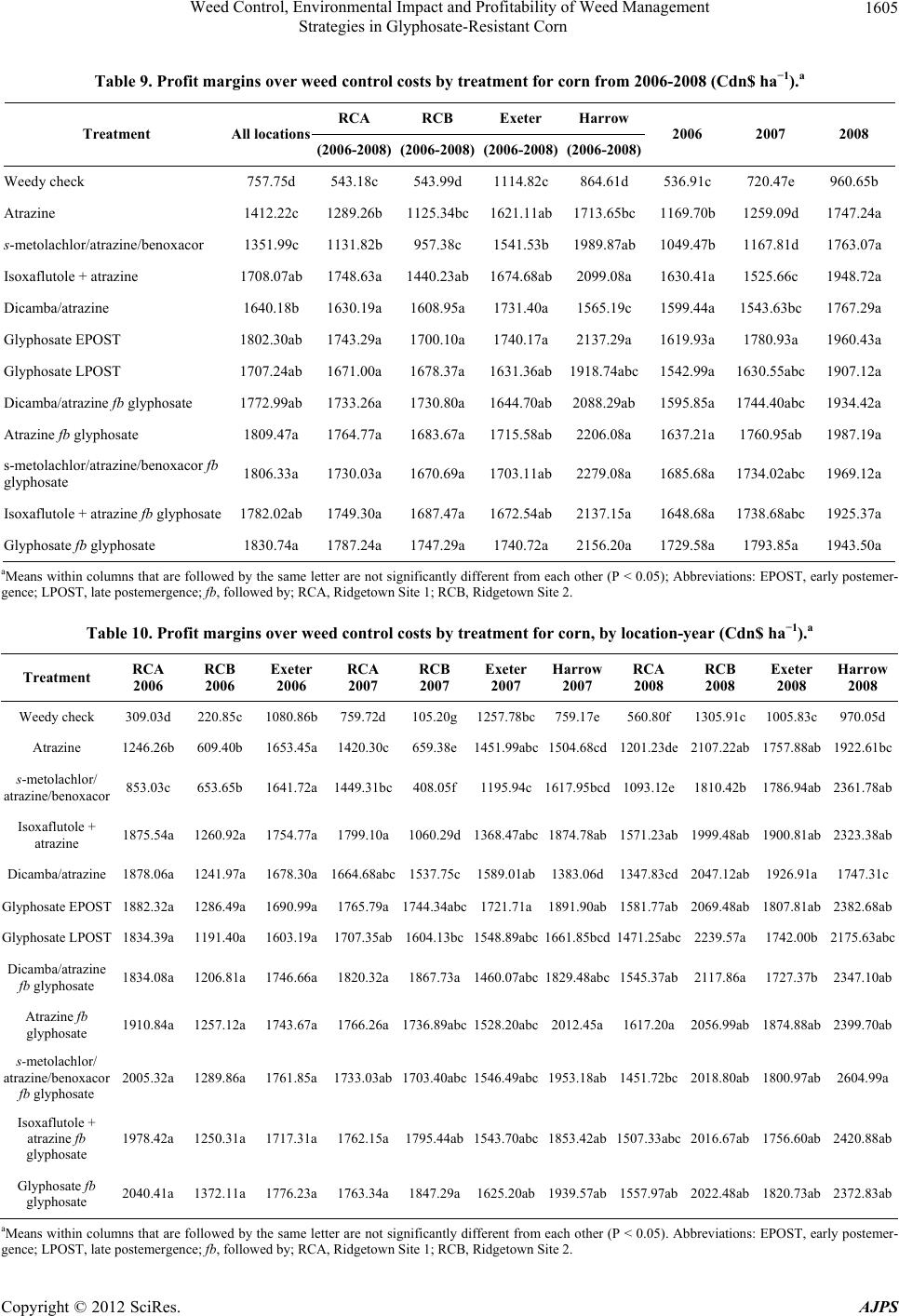 Weed Control, Environmental Impact and Profitability of Weed Management Strategies in Glyphosate-Resistant Corn 1605 Table 9. Profit margins over weed control costs by treatment for corn from 2006-2008 (Cdn$ ha−1).a RCA RCB Exeter Harrow Treatment All locations (2006-2008) (2006-2008) (2006-2008) (2006-2008) 2006 2007 2008 Weedy check 757.75d 543.18c 543.99d 1114.82c864.61d 536.91c 720.47e 960.65b Atrazine 1412.22c 1289.26b1125.34bc1621.11ab1713.65bc1169.70b 1259.09d 1747.24a s-metolachlor/atrazine/benoxacor 1351.99c 1131.82b957.38c 1541.53b1989.87ab1049.47b 1167.81d 1763.07a Isoxaflutole + atrazine 1708.07ab 1748.63a1440.23ab1674.68ab2099.08a1630.41a 1525.66c 1948.72a Dicamba/atrazine 1640.18b 1630.19a1608.95a1731.40a1565.19c1599.44a 1543.63bc 1767.29a Glyphosate EPOST 1802.30ab 1743.29a 1700.10a 1740.17a2137.29a 1619.93a 1780.93a 1960.43a Glyphosate LPOST 1707.24ab 1671.00a1678.37a1631.36ab1918.74abc 1542.99a 1630.55abc 1907.12a Dicamba/atrazine fb glyphosate 1772.99ab 1733.26a1730.80a1644.70ab2088.29ab1595.85a 1744.40abc 1934.42a Atrazine fb glyphosate 1809.47a 1764.77a1683.67a1715.58ab2206.08a1637.21a 1760.95ab 1987.19a s-metolachlor/atrazine/benoxacor fb glyphosate 1806.33a 1730.03a1670.69a1703.11ab2279.08a1685.68a 1734.02abc 1969.12a Isoxaflutole + atrazine fb glyphosate1782.02ab 1749.30a1687.47a1672.54ab2137.15a1648.68a 1738.68abc 1925.37a Glyphosate fb glyphosate 1830.74a 1787.24a 1747.29a 1740.72a 2156.20a 1729.58a 1793.85a 1943.50a aMeans within columns that are followed by the same letter are not significantly different from each other (P < 0.05); Abbreviations: EPOST, early postemer- gence; LPOST, late postemergence; fb, followed by; RCA, Ridgetown Site 1; RCB, Ridgetown Site 2. Table 10. Profit margins over weed control costs by treatment for corn, by location-year (Cdn$ ha−1).a Treatment RCA 2006 RCB 2006 Exeter 2006 RCA 2007 RCB 2007 Exeter 2007 Harrow 2007 RCA 2008 RCB 2008 Exeter 2008 Harrow 2008 Weedy check 309.03d 220.85c 1080.86b 759.72d105.20g1257.78bc759.17e560.80f 1305.91c 1005.83c970.05d Atrazine 1246.26b 609.40b 1653.45a 1420.30c659.38e1451.99abc1504.68cd1201.23de2107.22ab 1757.88ab1922.61bc s-metolachlor/ atrazine/benoxacor 853.03c 653.65b 1641.72a 1449.31bc408.05f 1195.94c1617.95bcd1093.12e1810.42b 1786.94ab2361.78ab Isoxaflutole + atrazine 1875.54a 1260.92a 1754.77a 1799.10a1060.29d1368.47abc1874.78ab1571.23ab1999.48ab 1900.81ab2323.38ab Dicamba/atrazine 1878.06a 1241.97a 1678.30a 1664.68abc1537.75c 1589.01ab1383.06d1347.83cd2047.12ab 1926.91a1747.31c Glyphosate EPOST 1882.32a 1286.49a 1690.99a 1765.79a1744.34abc1721.71a1891.90ab1581.77ab2069.48ab 1807.81ab2382.68ab Glyphosate LPOST 1834.39a 1191.40a 1603.19a 1707.35ab1604.13bc1548.89abc1661.85bcd1471.25abc 2239.57a 1742.00b2175.63abc Dicamba/atrazine fb glyphosate 1834.08a 1206.81a 1746.66a 1820.32a 1867.73a1460.07abc1829.48abc1545.37ab2117.86a 1727.37b2347.10ab Atrazine fb glyphosate 1910.84a 1257.12a 1743.67a 1766.26a1736.89abc1528.20abc2012.45a 1617.20a2056.99ab 1874.88ab2399.70ab s-metolachlor/ atrazine/benoxacor fb glyphosate 2005.32a 1289.86a 1761.85a 1733.03ab1703.40abc1546.49abc1953.18ab1451.72bc2018.80ab 1800.97ab2604.99a Isoxaflutole + atrazine fb glyphosate 1978.42a 1250.31a 1717.31a 1762.15a1795.44ab1543.70abc1853.42ab1507.33abc 2016.67ab 1756.60ab2420.88ab Glyphosate fb glyphosate 2040.41a 1372.11a 1776.23a 1763.34a 1847.29a1625.20ab1939.57ab1557.97ab2022.48ab 1820.73ab2372.83ab aMeans within columns that are followed by the same letter are not significantly different from each other (P < 0.05). Abbreviations: EPOST, early postemer- ence; LPOST, late postemergence; fb, followed by; RCA, Ridgetown Site 1; RCB, Ridgetown Site 2. g Copyright © 2012 SciRes. AJPS 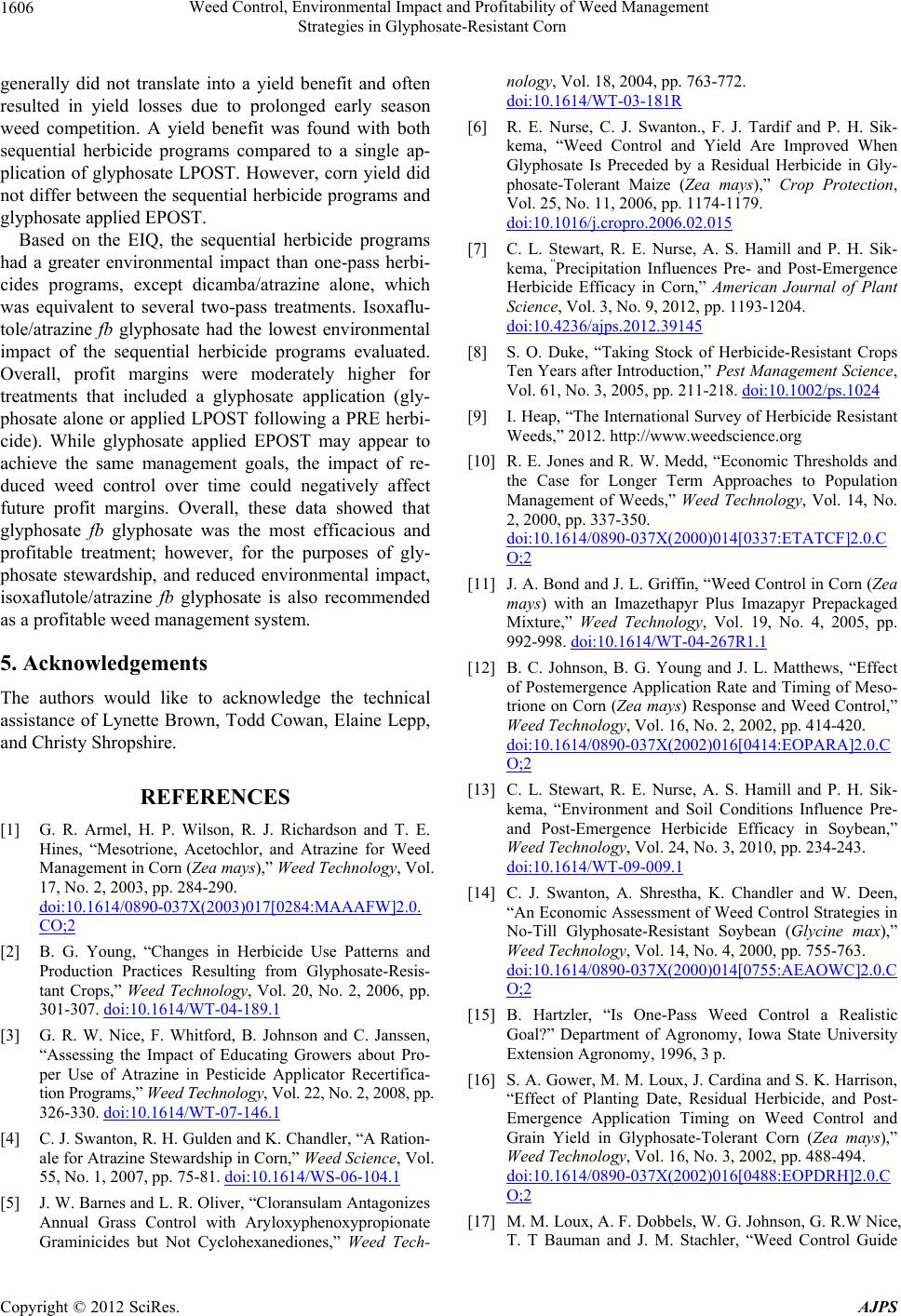 Weed Control, Environmental Impact and Profitability of Weed Management Strategies in Glyphosate-Resistant Corn 1606 generally did not translate into a yield benefit and often resulted in yield losses due to prolonged early season weed competition. A yield benefit was found with both sequential herbicide programs compared to a single ap- plication of glyphosate LPOST. However, corn yield did not differ between the sequential herbicide programs and glyphosate applied EPOST. Based on the EIQ, the sequential herbicide programs had a greater environmental impact than one-pass herbi- cides programs, except dicamba/atrazine alone, which was equivalent to several two-pass treatments. Isoxaflu- tole/atrazine fb glyphosate had the lowest environmental impact of the sequential herbicide programs evaluated. Overall, profit margins were moderately higher for treatments that included a glyphosate application (gly- phosate alone or applied LPOST following a PRE herbi- cide). While glyphosate applied EPOST may appear to achieve the same management goals, the impact of re- duced weed control over time could negatively affect future profit margins. Overall, these data showed that glyphosate fb glyphosate was the most efficacious and profitable treatment; however, for the purposes of gly- phosate stewardship, and reduced environmental impact, isoxaflutole/atrazine fb glyphosate is also recommended as a profitable weed management system. 5. Acknowledgements The authors would like to acknowledge the technical assistance of Lynette Brown, Todd Cowan, Elaine Lepp, and Christy Shropshire. REFERENCES [1] G. R. Armel, H. P. Wilson, R. J. Richardson and T. E. Hines, “Mesotrione, Acetochlor, and Atrazine for Weed Management in Corn (Zea mays),” Weed Technology, Vol. 17, No. 2, 2003, pp. 284-290. doi:10.1614/0890-037X(2003)017[0284:MAAAFW]2.0. CO;2 [2] B. G. Young, “Changes in Herbicide Use Patterns and Production Practices Resulting from Glyphosate-Resis- tant Crops,” Weed Technology, Vol. 20, No. 2, 2006, pp. 301-307. doi:10.1614/WT-04-189.1 [3] G. R. W. Nice, F. Whitford, B. Johnson and C. Janssen, “Assessing the Impact of Educating Growers about Pro- per Use of Atrazine in Pesticide Applicator Recertifica- tion Programs,” Weed Technology, Vol. 22, No. 2, 2008, pp. 326-330. doi:10.1614/WT-07-146.1 [4] C. J. Swanton, R. H. Gulden and K. Chandler, “A Ration- ale for Atrazine Stewardship in Corn,” Weed Science, Vol. 55, No. 1, 2007, pp. 75-81. doi:10.1614/WS-06-104.1 [5] J. W. Barnes and L. R. Oliver, “Cloransulam Antagonizes Annual Grass Control with Aryloxyphenoxypropionate Graminicides but Not Cyclohexanediones,” Weed Tech- nology, Vol. 18, 2004, pp. 763-772. doi:10.1614/WT-03-181R [6] R. E. Nurse, C. J. Swanton., F. J. Tardif and P. H. Sik- kema, “Weed Control and Yield Are Improved When Glyphosate Is Preceded by a Residual Herbicide in Gly- phosate-Tolerant Maize (Zea mays),” Crop Protection, Vol. 25, No. 11, 2006, pp. 1174-1179. doi:10.1016/j.cropro.2006.02.015 [7] C. L. Stewart, R. E. Nurse, A. S. Hamill and P. H. Sik- kema, “Precipitation Influences Pre- and Post-Emergence Herbicide Efficacy in Corn,” American Journal of Plant Science, Vol. 3, No. 9, 2012, pp. 1193-1204. doi:10.4236/ajps.2012.39145 [8] S. O. Duke, “Taking Stock of Herbicide-Resistant Crops Ten Years after Introduction,” Pest Management Science, Vol. 61, No. 3, 2005, pp. 211-218. doi:10.1002/ps.1024 [9] I. Heap, “The International Survey of Herbicide Resistant Weeds,” 2012. http://www.weedscience.org [10] R. E. Jones and R. W. Medd, “Economic Thresholds and the Case for Longer Term Approaches to Population Management of Weeds,” Weed Technology, Vol. 14, No. 2, 2000, pp. 337-350. doi:10.1614/0890-037X(2000)014[0337:ETATCF]2.0.C O;2 [11] J. A. Bond and J. L. Griffin, “Weed Control in Corn (Zea mays) with an Imazethapyr Plus Imazapyr Prepackaged Mixture,” Weed Technology, Vol. 19, No. 4, 2005, pp. 992-998. doi:10.1614/WT-04-267R1.1 [12] B. C. Johnson, B. G. Young and J. L. Matthews, “Effect of Postemergence Application Rate and Timing of Meso- trione on Corn (Zea mays) Response and Weed Control,” Weed Technology, Vol. 16, No. 2, 2002, pp. 414-420. doi:10.1614/0890-037X(2002)016[0414:EOPARA]2.0.C O;2 [13] C. L. Stewart, R. E. Nurse, A. S. Hamill and P. H. Sik- kema, “Environment and Soil Conditions Influence Pre- and Post-Emergence Herbicide Efficacy in Soybean,” Weed Technology, Vol. 24, No. 3, 2010, pp. 234-243. doi:10.1614/WT-09-009.1 [14] C. J. Swanton, A. Shrestha, K. Chandler and W. Deen, “An Economic Assessment of Weed Control Strategies in No-Till Glyphosate-Resistant Soybean (Glycine max),” Weed Technology, Vol. 14, No. 4, 2000, pp. 755-763. doi:10.1614/0890-037X(2000)014[0755:AEAOWC]2.0.C O;2 [15] B. Hartzler, “Is One-Pass Weed Control a Realistic Goal?” Department of Agronomy, Iowa State University Extension Agronomy, 1996, 3 p. [16] S. A. Gower, M. M. Loux, J. Cardina and S. K. Harrison, “Effect of Planting Date, Residual Herbicide, and Post- Emergence Application Timing on Weed Control and Grain Yield in Glyphosate-Tolerant Corn (Zea mays),” Weed Technology, Vol. 16, No. 3, 2002, pp. 488-494. doi:10.1614/0890-037X(2002)016[0488:EOPDRH]2.0.C O;2 [17] M. M. Loux, A. F. Dobbels, W. G. Johnson, G. R.W Nice, T. T Bauman and J. M. Stachler, “Weed Control Guide Copyright © 2012 SciRes. AJPS 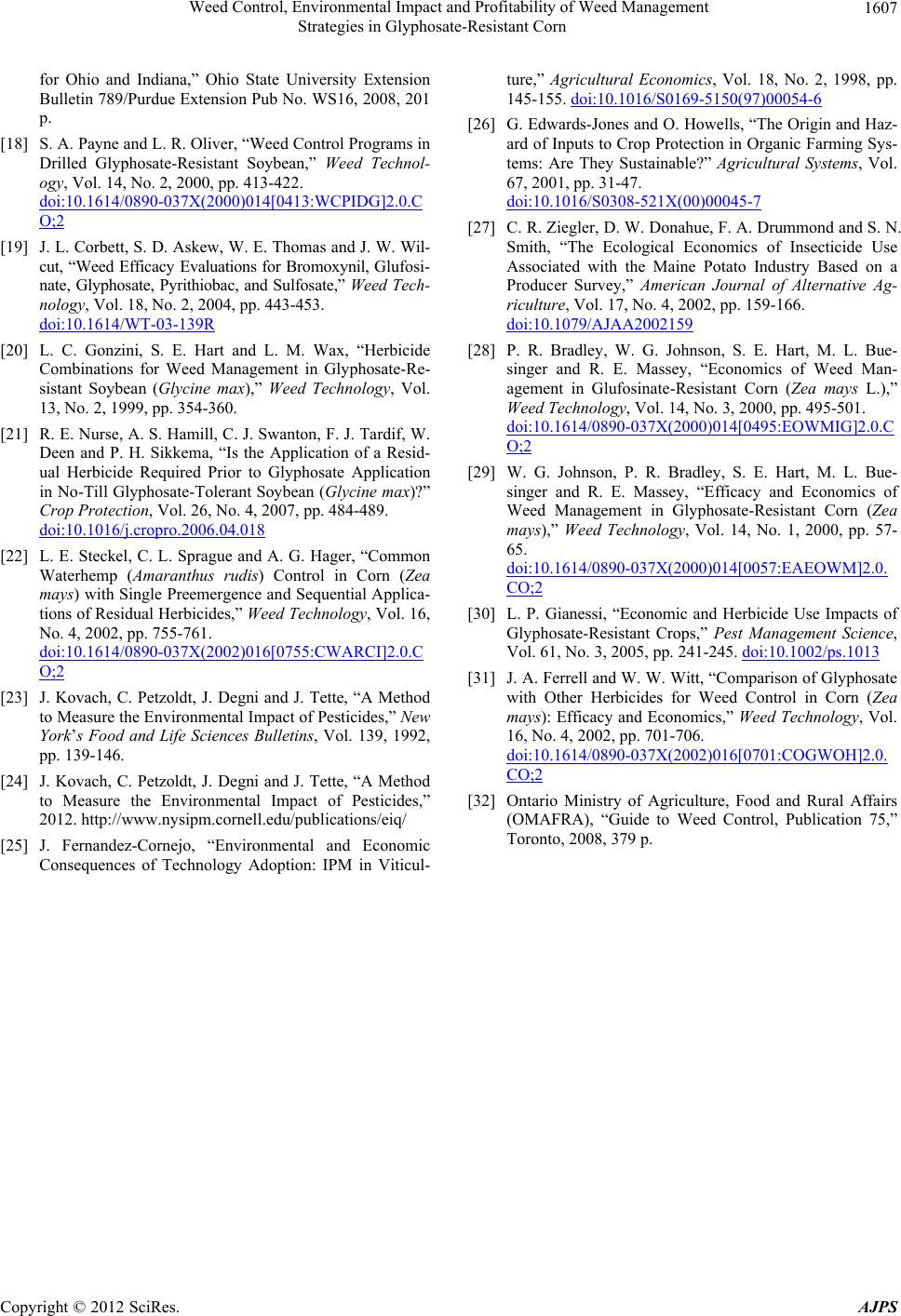 Weed Control, Environmental Impact and Profitability of Weed Management Strategies in Glyphosate-Resistant Corn 1607 for Ohio and Indiana,” Ohio State University Extension Bulletin 789/Purdue Extension Pub No. WS16, 2008, 201 p. [18] S. A. Payne and L. R. Oliver, “Weed Control Programs in Drilled Glyphosate-Resistant Soybean,” Weed Technol- ogy, Vol. 14, No. 2, 2000, pp. 413-422. doi:10.1614/0890-037X(2000)014[0413:WCPIDG]2.0.C O;2 [19] J. L. Corbett, S. D. Askew, W. E. Thomas and J. W. Wil- cut, “Weed Efficacy Evaluations for Bromoxynil, Glufosi- nate, Glyphosate, Pyrithiobac, and Sulfosate,” Weed Tech- nology, Vol. 18, No. 2, 2004, pp. 443-453. doi:10.1614/WT-03-139R [20] L. C. Gonzini, S. E. Hart and L. M. Wax, “Herbicide Combinations for Weed Management in Glyphosate-Re- sistant Soybean (Glycine max),” Weed Technology, Vol. 13, No. 2, 1999, pp. 354-360. [21] R. E. Nurse, A. S. Hamill, C. J. Swanton, F. J. Tardif, W. Deen and P. H. Sikkema, “Is the Application of a Resid- ual Herbicide Required Prior to Glyphosate Application in No-Till Glyphosate-Tolerant Soybean (Glycine max)?” Crop Protection, Vol. 26, No. 4, 2007, pp. 484-489. doi:10.1016/j.cropro.2006.04.018 [22] L. E. Steckel, C. L. Sprague and A. G. Hager, “Common Waterhemp (Amaranthus rudis) Control in Corn (Zea mays) with Single Preemergence and Sequential Applica- tions of Residual Herbicides,” Weed Technology, Vol. 16, No. 4, 2002, pp. 755-761. doi:10.1614/0890-037X(2002)016[0755:CWARCI]2.0.C O;2 [23] J. Kovach, C. Petzoldt, J. Degni and J. Tette, “A Method to Measure the Environmental Impact of Pesticides,” New York’s Food and Life Sciences Bulletins, Vol. 139, 1992, pp. 139-146. [24] J. Kovach, C. Petzoldt, J. Degni and J. Tette, “A Method to Measure the Environmental Impact of Pesticides,” 2012. http://www.nysipm.cornell.edu/publications/eiq/ [25] J. Fernandez-Cornejo, “Environmental and Economic Consequences of Technology Adoption: IPM in Viticul- ture,” Agricultural Economics, Vol. 18, No. 2, 1998, pp. 145-155. doi:10.1016/S0169-5150(97)00054-6 [26] G. Edwards-Jones and O. Howells, “The Origin and Haz- ard of Inputs to Crop Protection in Organic Farming Sys- tems: Are They Sustainable?” Agricultural Systems, Vol. 67, 2001, pp. 31-47. doi:10.1016/S0308-521X(00)00045-7 [27] C. R. Ziegler, D. W. Donahue, F. A. Drummond and S. N. Smith, “The Ecological Economics of Insecticide Use Associated with the Maine Potato Industry Based on a Producer Survey,” American Journal of Alternative Ag- riculture, Vol. 17, No. 4, 2002, pp. 159-166. doi:10.1079/AJAA2002159 [28] P. R. Bradley, W. G. Johnson, S. E. Hart, M. L. Bue- singer and R. E. Massey, “Economics of Weed Man- agement in Glufosinate-Resistant Corn (Zea mays L.),” Weed Technology, Vol. 14, No. 3, 2000, pp. 495-501. doi:10.1614/0890-037X(2000)014[0495:EOWMIG]2.0.C O;2 [29] W. G. Johnson, P. R. Bradley, S. E. Hart, M. L. Bue- singer and R. E. Massey, “Efficacy and Economics of Weed Management in Glyphosate-Resistant Corn (Zea mays),” Weed Technology, Vol. 14, No. 1, 2000, pp. 57- 65. doi:10.1614/0890-037X(2000)014[0057:EAEOWM]2.0. CO;2 [30] L. P. Gianessi, “Economic and Herbicide Use Impacts of Glyphosate-Resistant Crops,” Pest Management Science, Vol. 61, No. 3, 2005, pp. 241-245. doi:10.1002/ps.1013 [31] J. A. Ferrell and W. W. Witt, “Comparison of Glyphosate with Other Herbicides for Weed Control in Corn (Zea mays): Efficacy and Economics,” Weed Technology, Vol. 16, No. 4, 2002, pp. 701-706. doi:10.1614/0890-037X(2002)016[0701:COGWOH]2.0. CO;2 [32] Ontario Ministry of Agriculture, Food and Rural Affairs (OMAFRA), “Guide to Weed Control, Publication 75,” Toronto, 2008, 379 p. Copyright © 2012 SciRes. AJPS |

